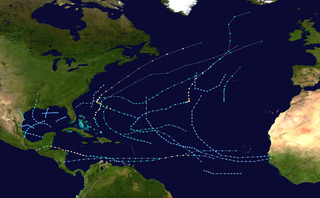
The 1997 Atlantic hurricane season was a below-average hurricane season. It officially began on June 1, and lasted until November 30. These dates conventionally delimit the period of each year when most tropical cyclones form in the Atlantic basin. The 1997 season was inactive, with only seven named storms forming, with an additional tropical depression and an unnumbered subtropical storm. It was the first time since the 1961 season that there were no active tropical cyclones in the Atlantic basin during the entire month of August–historically one of the more active months of the season—a phenomenon that would not occur again until 2022. A strong El Niño is credited with reducing activity in the Atlantic, while increasing the number of storms in the eastern and western Pacific basins to 19 and 26 storms, respectively. As is common in El Niño years, tropical cyclogenesis was suppressed in the tropical latitudes, with only two becoming tropical storms south of 25°N.

The 1978 Atlantic hurricane season was the last Atlantic hurricane season to use an all-female naming list. The season officially began on June 1, and ended on November 30. It was an above average season due to a subsiding El Niño. The first storm, a subtropical storm, developed unusually early – on January 18 – and dissipated five days later without causing any damage. At the end of July and early August, short-lived Tropical Storm Amelia caused extensive flooding in Texas after dropping as much as 48 in (1,200 mm) of rain. There were 33 deaths and US$110 million in damage. Tropical Storm Bess and Hurricane Cora resulted in only minor land impacts, while the latter was attributed to one fatality.

The 1949 Atlantic hurricane season was the last season that tropical cyclones were not publicly labeled by the United States Weather Bureau. It officially began on June 15, and lasted until November 15. These dates conventionally delimit the period of each year when most tropical cyclones form in the Atlantic basin. The first storm, a tropical depression, developed in the northern Gulf of Mexico on August 14. The final system, Tropical Storm Sixteen, dissipated in the southwestern Caribbean Sea on November 5. It was a fairly active season, featuring 16 tropical storms and seven hurricanes. Two of these strengthened into major hurricanes, which are Category 3 or higher on the Saffir–Simpson hurricane wind scale.
The name Grace has been used for nineteen tropical cyclones worldwide: six in the Atlantic Ocean, ten in the Western Pacific Ocean, two in the Australian region of the South Pacific Ocean. and one in the South-West Indian Ocean.
The name Bertha has been used for eight tropical cyclones in the Atlantic Ocean.
The name Gustav was used for five tropical cyclones in the Atlantic Ocean:
The name Barry has been used for seven tropical cyclones in the Atlantic Ocean and for one in the Australian Region.
The name Gabrielle has been used for eight tropical cyclones worldwide, six in the Atlantic Ocean and two in the Indian Ocean.
The name Ernesto has been used for seven tropical cyclones in the Atlantic Ocean.
The name Florence has been used for ten tropical cyclones in the Atlantic Ocean and five tropical cyclones in the Eastern Pacific Ocean.

The 1997 Pacific hurricane season was a very active hurricane season. With hundreds of deaths and hundreds of millions of dollars in damage, this season was one of the costliest and deadliest Pacific hurricane seasons. This was due to the exceptionally strong 1997–98 El Niño event. The season officially started on May 15, in the eastern Pacific, and on June 1, in the central Pacific, and lasted until November 30. These dates conventionally delimit the period of each year when almost all tropical cyclones form in the northeastern Pacific Ocean.

The 2009 Atlantic hurricane season was a below-average Atlantic hurricane season that produced eleven tropical cyclones, nine named storms, three hurricanes, and two major hurricanes. It officially began on June 1 and ended on November 30, dates that conventionally delimit the period of each year when most tropical cyclones develop in the Atlantic basin. The season's first tropical cyclone, Tropical Depression One, developed on May 28, while the final storm, Hurricane Ida, dissipated on November 10. The most intense hurricane, Bill, was a powerful Cape Verde-type hurricane that affected areas from the Leeward Islands to Newfoundland. The season featured the lowest number of tropical cyclones since the 1997 season, and only one system, Claudette, made landfall in the United States. Forming from the interaction of a tropical wave and an upper-level low, Claudette made landfall on the Florida Panhandle with maximum sustained winds of 45 mph (70 km/h) before quickly dissipating over Alabama. The storm killed two people and caused $228,000 in damage.
The name Chantal has been used for eight tropical cyclones worldwide: seven in the Atlantic Ocean and one in the South-West Indian Ocean.
This page is based on this
Wikipedia article Text is available under the
CC BY-SA 4.0 license; additional terms may apply.
Images, videos and audio are available under their respective licenses.




